几种特殊句式讲解及练习-倒装句、强调句、反意疑问句、祈使句
安徽专升本英语常考语法之强调句、倒装句、反义疑问句.
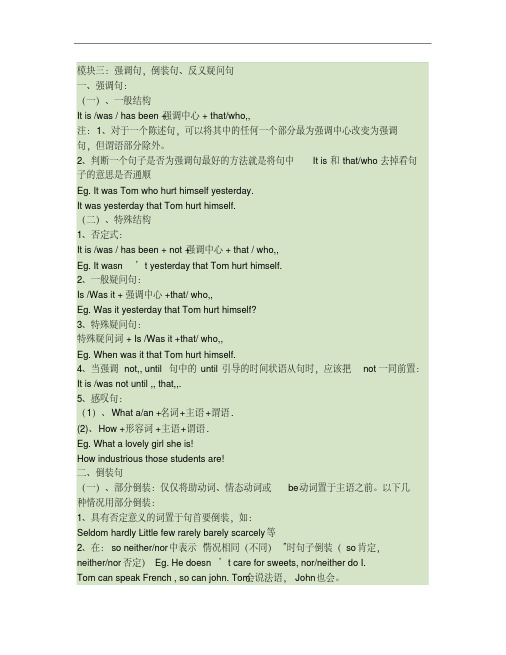
模块三:强调句,倒装句、反义疑问句一、强调句:(一)、一般结构It is /was / has been +强调中心+ that/who,,注:1、对于一个陈述句,可以将其中的任何一个部分最为强调中心改变为强调句,但谓语部分除外。
2、判断一个句子是否为强调句最好的方法就是将句中It is 和that/who 去掉看句子的意思是否通顺Eg. It was Tom who hurt himself yesterday.It was yesterday that Tom hurt himself.(二)、特殊结构1、否定式:It is /was / has been + not +强调中心+ that / who,,Eg. It wasn’t yesterday that Tom hurt himself.2、一般疑问句:Is /Was it + 强调中心+that/ who,,Eg. Was it yesterday that Tom hurt himself?3、特殊疑问句:特殊疑问词+ Is /Was it +that/ who,,Eg. When was it that Tom hurt himself.4、当强调not,, until 句中的until 引导的时间状语从句时,应该把 not 一同前置:It is /was not until ,, that,,.5、感叹句:(1)、What a/an +名词+主语+谓语.(2)、How +形容词+主语+谓语.Eg. What a lovely girl she is!How industrious those students are!二、倒装句(一)、部分倒装:仅仅将助动词、情态动词或be动词置于主语之前。
以下几种情况用部分倒装:1、具有否定意义的词置于句首要倒装,如:Seldom hardly Little few rarely barely scarcely等2、在:so neither/nor 中表示“情况相同(不同)”时句子倒装(so肯定,neither/nor 否定)Eg. He doesn’t care for sweets, nor/neither do I.Tom can speak French , so can john. Tom会说法语,John 也会。
特殊句式的类型
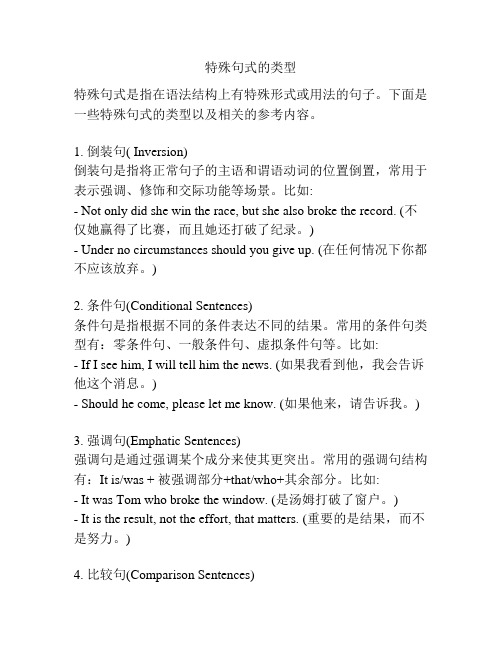
特殊句式的类型特殊句式是指在语法结构上有特殊形式或用法的句子。
下面是一些特殊句式的类型以及相关的参考内容。
1. 倒装句( Inversion)倒装句是指将正常句子的主语和谓语动词的位置倒置,常用于表示强调、修饰和交际功能等场景。
比如:- Not only did she win the race, but she also broke the record. (不仅她赢得了比赛,而且她还打破了纪录。
)- Under no circumstances should you give up. (在任何情况下你都不应该放弃。
)2. 条件句(Conditional Sentences)条件句是指根据不同的条件表达不同的结果。
常用的条件句类型有:零条件句、一般条件句、虚拟条件句等。
比如:- If I see him, I will tell him the news. (如果我看到他,我会告诉他这个消息。
)- Should he come, please let me know. (如果他来,请告诉我。
)3. 强调句(Emphatic Sentences)强调句是通过强调某个成分来使其更突出。
常用的强调句结构有:It is/was + 被强调部分+that/who+其余部分。
比如:- It was Tom who broke the window. (是汤姆打破了窗户。
)- It is the result, not the effort, that matters. (重要的是结果,而不是努力。
)4. 比较句(Comparison Sentences)比较句是用来比较两个对象或者描述相对关系的句子。
常用的比较句结构有:as+adj./adv. +as, not as+adj./adv.+as,more/less+adj./adv.+ than等。
比如:- He runs as fast as a cheetah. (他跑得像一只猎豹一样快。
超实用高考英语专题复习:专题07 特殊句式 (复习思维导图+必备知识手册)
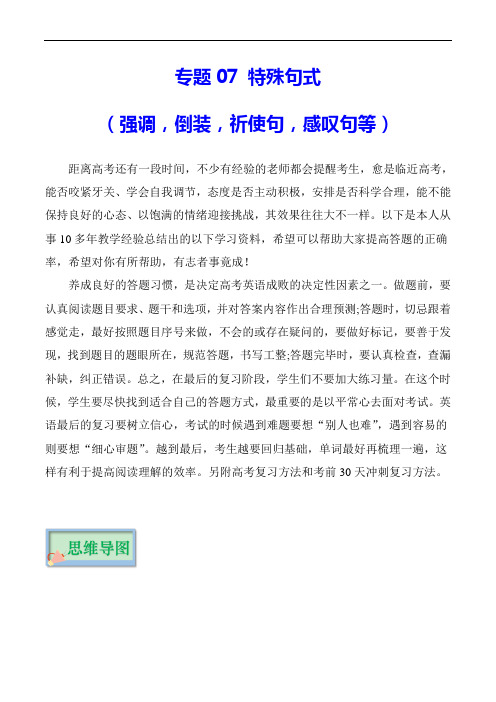
专题07 特殊句式(强调,倒装,祈使句,感叹句等)距离高考还有一段时间,不少有经验的老师都会提醒考生,愈是临近高考,能否咬紧牙关、学会自我调节,态度是否主动积极,安排是否科学合理,能不能保持良好的心态、以饱满的情绪迎接挑战,其效果往往大不一样。
以下是本人从事10多年教学经验总结出的以下学习资料,希望可以帮助大家提高答题的正确率,希望对你有所帮助,有志者事竟成!养成良好的答题习惯,是决定高考英语成败的决定性因素之一。
做题前,要认真阅读题目要求、题干和选项,并对答案内容作出合理预测;答题时,切忌跟着感觉走,最好按照题目序号来做,不会的或存在疑问的,要做好标记,要善于发现,找到题目的题眼所在,规范答题,书写工整;答题完毕时,要认真检查,查漏补缺,纠正错误。
总之,在最后的复习阶段,学生们不要加大练习量。
在这个时候,学生要尽快找到适合自己的答题方式,最重要的是以平常心去面对考试。
英语最后的复习要树立信心,考试的时候遇到难题要想“别人也难”,遇到容易的则要想“细心审题”。
越到最后,考生越要回归基础,单词最好再梳理一遍,这样有利于提高阅读理解的效率。
另附高考复习方法和考前30天冲刺复习方法。
考点1 倒装倒装是英语中常见的一种语言现象,它具有强调、修饰等作用。
倒装可分为完全倒装和部分倒装。
一、完全倒装完全倒装是指将句子中的谓语动词全部置于主语之前。
此结构通常只用于一般现在时或一般过去时。
常见的结构有:1. There be句型:其中be可换成live, lie, stand, remain, exist, come, go, seem (appear/ happen/ used) to be等表示"存在"意义的词。
☛There entered a strange little man. 走进来一个奇怪而身材矮小的人。
☛Once there lived an old fisherman in a village by the sea. 从前,海边的一个村子里住着一位老渔夫。
倒装,强调,反义疑问句,感叹句
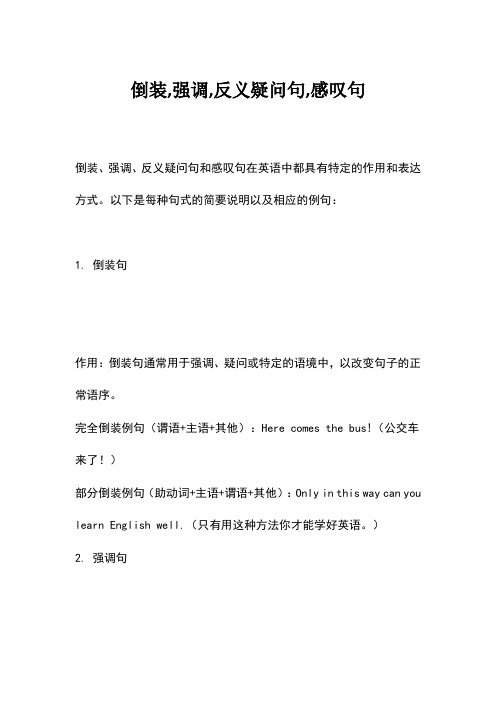
倒装,强调,反义疑问句,感叹句
倒装、强调、反义疑问句和感叹句在英语中都具有特定的作用和表达方式。
以下是每种句式的简要说明以及相应的例句:
1. 倒装句
作用:倒装句通常用于强调、疑问或特定的语境中,以改变句子的正常语序。
完全倒装例句(谓语+主语+其他):Here comes the bus!(公交车来了!)
部分倒装例句(助动词+主语+谓语+其他):Only in this way can you learn English well.(只有用这种方法你才能学好英语。
)
2. 强调句
作用:强调句用于突出句子中的特定信息,通常是使用“It was … that”结构。
例句:It was John who broke the window.(是约翰打破了窗户。
)3. 反义疑问句
作用:反义疑问句用于确认或询问信息,通常由陈述句和一个附加的简短疑问句组成。
例句:You are coming to the party, aren't you?(你要来参加聚会,不是吗?)
4. 感叹句
作用:感叹句用于表达强烈的情感,如惊讶、喜悦、愤怒等。
通常由what或how引导。
What引导的例句:What a beautiful day it is!(天气多好啊!)How引导的例句:How fast he runs!(他跑得多快啊!)。
英语特殊句式归纳整理

英语特殊句式归纳整理用来表示说话人强烈的喜、怒、哀、乐等感情的句子,叫感叹句。
感叹句由what或how 引导,具体用法如下表:祈使句的基本用法祈使句是用来表示命令、请求、建议或劝告等的句子。
常省略主语,谓语动词用原形。
1. 肯定的祈使句①句型:动词原形+其他成分。
Be careful!小心!②"Do+祈使句"表示一种强烈的感情或请求,do起强调作用。
③please用在祈使句中可以表示一种客气的语气,但please用在句末时,必须用逗号与其余部分隔开。
Close the door, please. 请关门。
2. 否定的祈使句①常用句型:Don’t+动词原形+其他成分。
Don’t be late for school again! 别再迟到了!②用Never开头:Never+动词原形+其他成分。
Never leave today’s work for tomorrow! 不要把今天的工作留到明天!3. Let引导的祈使句以Let开头的句子也是祈使句,表示陈述和建议。
其否定形式有两种:Let...not或Don’t...Let us not be late. 让我们不要迟到。
Don’t let the boy play football in the street. 不要让这个男孩在街上踢足球。
祈使句与简单句、复合句之间的转换1. "Let’s + 动词原形+ 其他"可转换为"Shall we + 动词原形+ 其他? "。
Let’s go fishing this afternoon. =Shall we go fishing this afternoon?2. "祈使句+ and/or + 简单句"可转换为含if引导的条件状语从句的复合句。
Use your head, and you’ll find a way. =If you use your head, you’ll find a way. Hurry up, or we’ll be late. =If we don’t hurry up, we’ll be late.祈使句的应答语1. 以Let’s开头的祈使句,其答语常用Good idea. /OK. /Yes, I’d love to.等。
高中英语特殊句式-倒装句和强调句
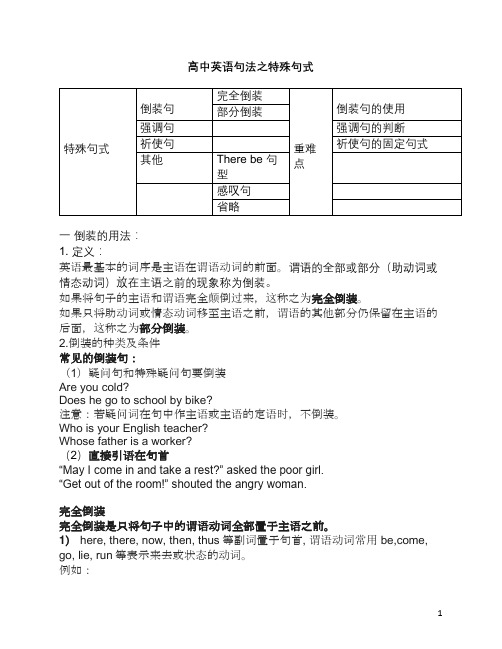
高中英语句法之特殊句式一倒装的用法:1. 定义:英语最基本的词序是主语在谓语动词的前面。
谓语的全部或部分(助动词或情态动词)放在主语之前的现象称为倒装。
如果将句子的主语和谓语完全颠倒过来,这称之为完全倒装。
如果只将助动词或情态动词移至主语之前,谓语的其他部分仍保留在主语的后面,这称之为部分倒装。
2.倒装的种类及条件常见的倒装句:(1)疑问句和特殊疑问句要倒装Are you cold?Does he go to school by bike?注意:若疑问词在句中作主语或主语的定语时,不倒装。
Who is your English teacher?Whose father is a worker?(2)直接引语在句首“May I come in and take a rest?” asked the poor girl.“Get out of the room!” shouted the angry woman.完全倒装完全倒装是只将句子中的谓语动词全部置于主语之前。
1) here, there, now, then, thus等副词置于句首, 谓语动词常用be,come, go, lie, run等表示来去或状态的动词。
例如:Here comes the bus! (=The bus is coming here! 用一般现在时表示正在进行的动作。
)There goes the bell! = The bell is ringing. 铃响了!Then came the chairman. 那时总裁来了。
Then came the hour we had been looking forward to.我们期盼的时候到了。
Here is your letter. 你的信。
2)表示运动方向的副词或地点状语置于句首,以out, in, up, down, off, away等副词开头,谓语动词是表示“移动”的go, come, leave等句子里。
【高考】英语语法复习特殊句式倒装句,强调句,反义疑问句,感叹句,祈使句,省略和主谓一致 教学课件

1st week
2nd week
3rd week
句子成分 冠词 代词
形容词和副词 语义辨析
动词和动词词组 动词的时态和语态
并列句和状语从句 特殊句式
非谓语动词
情态动词和虚拟语气
定语从句和名词性从句
感叹句、祈使句
反义疑问句 倒装句、强调句
表示说话时强烈感情
What a cute cat!
强调句
结构: It is/was +被强调部分+that/who+其他成分
强调结构
单词 短语 从句
强调成分
主语 宾语 状语
强调句
结构: It is/was +被强调部分+that/who+其他成分
It is I who/that am right.
主语
It was him that/who we met at the school gate.
Someone likes my voice, ________?
4.如果陈述句的主语是something, nothing, anything, everything 等不定代词时,反意疑问部分的主语多用it。 陈述部分主语是everyone, everybody, someone, somebody, anybody, no one, nobody等时,疑问部分用they, he;
Let’s go to the park, shall we?
Let us help you, will you?
主句主语为I/we,谓语动词是 think, suppose, expect, believe, imagine等
I think he is a good student, isn’t he? We don’t think you are right, are you?
中考考点专题归纳--特殊句式

中考考点专题归纳--特殊句式中考考点专题归纳—特殊句式特殊句式包括:反意疑问句、感叹句、祈使句、省略句、倒装句。
一:反意疑问句(前后相反)Ⅰ:作法:先作一个疑问句,再作反意。
1.反问部分谓语的判断,反问部分的谓语看原句。
采用“系对系,情对情,助对助”原则2.反问部分主语的判断,反问部分的主语必须是代词。
如果原句的主语是代词则可以直接用,如果原句的主语不是代词要变为代词再用。
主语是物单数用it,复数用they.主语是人,单数用he / she, 复数用they.特殊情况:①:当原句的主语是there时,疑问部分的主语也为there.②:当原句的主语是this / that时,疑问部分的主语为it.③:当原句的主语是these / those时,疑问部分的主语为 they.④:当原句的主语是以body / one结尾的不定代词时,疑问部分的主语为he.⑤:当原句的主语是以thing结尾的不定代词时,疑问部分的主语为it.⑥:当原句的主语是不定式、动名词、分词时,疑问部分的主语为it.3. 判断句式。
否定句的判断。
①:原句中有“not”时,句子为否定句。
②:原句中有“no或以no开头的不定代词”时句子为否定句。
③:原句中有“little、few、never、hardly、scarely”时,句子为否定句。
④:原句中有“too…to , neither… nor ”时,句子为否定句。
Ⅱ:特殊情况:当句子中有“unhappy、dislike”时,句子为肯定句。
理由像这种加了否定前缀而构成的否定词只能否定这个词本身而不能否定整个句子。
Ⅲ:特殊句子的反意疑问句1.以“let’s”开头的句子反问部分用→shall we?2.以“let us”开头的句子反问部分用→will you?3.原句是祈使句,反问部分用→will you?4.原句是I don’t think + 句子,反问部分以think 后的句子为准确定主语和谓语,此时机子为否定句。
句子的特殊句式有哪些
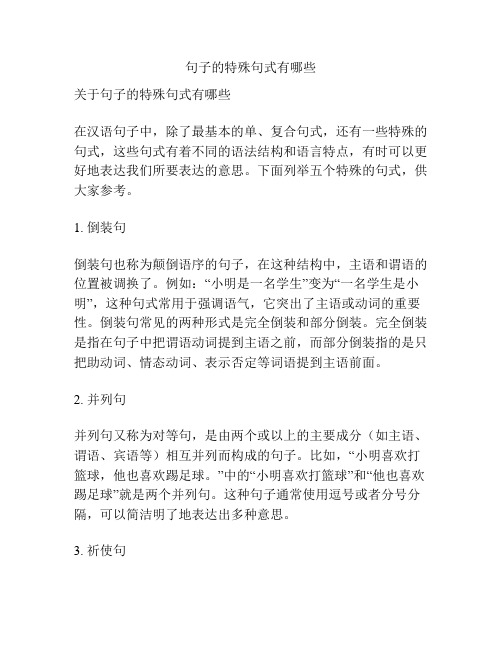
句子的特殊句式有哪些关于句子的特殊句式有哪些在汉语句子中,除了最基本的单、复合句式,还有一些特殊的句式,这些句式有着不同的语法结构和语言特点,有时可以更好地表达我们所要表达的意思。
下面列举五个特殊的句式,供大家参考。
1. 倒装句倒装句也称为颠倒语序的句子,在这种结构中,主语和谓语的位置被调换了。
例如:“小明是一名学生”变为“一名学生是小明”,这种句式常用于强调语气,它突出了主语或动词的重要性。
倒装句常见的两种形式是完全倒装和部分倒装。
完全倒装是指在句子中把谓语动词提到主语之前,而部分倒装指的是只把助动词、情态动词、表示否定等词语提到主语前面。
2. 并列句并列句又称为对等句,是由两个或以上的主要成分(如主语、谓语、宾语等)相互并列而构成的句子。
比如,“小明喜欢打篮球,他也喜欢踢足球。
”中的“小明喜欢打篮球”和“他也喜欢踢足球”就是两个并列句。
这种句子通常使用逗号或者分号分隔,可以简洁明了地表达出多种意思。
3. 祈使句祈使句也称为命令句,是表达命令、请求或建议的一种句型。
这种句子通常省略了主语,使用动词原形或者动词不定式,如:“过来!”、“请你帮我一下。
”、“不要挂断电话。
”这种句子通常灵活简洁,语气强烈,是生活中常用的一种句子结构。
4. 疑问句疑问句是指询问对方或自己是否了解某事的句子结构,其语调和词序都有所变化。
疑问句分为直接疑问句和间接疑问句。
直接疑问句是直接用疑问词提问,如“你在哪里?”而间接疑问句则由疑问句转述而来,如“我想知道你在哪里。
”5. 广义修饰句广义修饰句是由动词、形容词、副词、介词短语、不定式短语等修饰成分加上定语从句,构成一个复杂的修饰结构。
对于这种结构的句子,我们需要仔细分析句子成分之间的关系,找出主句和定语从句,才能完整理解其含义。
如:“他发现那个女孩,她和他小时候住在同一层楼。
”中的“那个女孩”是主句的宾语,而“她和他小时候住在同一层楼”是定语从句进一步修饰“那个女孩”。
高考英语反意疑问句、祈使句、感叹句以及其它特殊句式
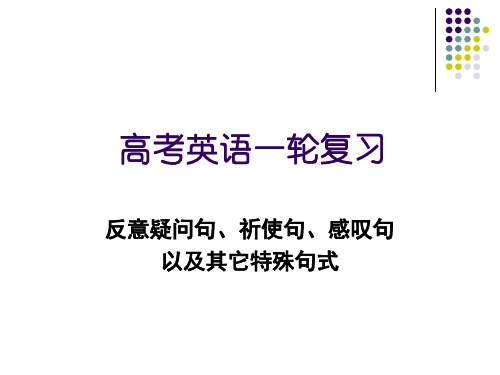
二十、反意疑问句的回答要克服中文思维, 用事实进行回答, 是就用yes, 不是就用no:
1. ---You aren’t a lawyer, are you?
---Yes, I am. 2. ---He hasn’t been to the Great Wall, has he?
---No, he hasn’t.
1. He scarcely knew a word of English, did he?
2. You seldom work on Sundays, do you?
3. He had little time to spare, did he?
十六、当主句的动词have 表示“拥有”时, 附加疑问既可用have也可用do: 1. You have a color TV set, haven’t you/ don’t you? 当主句的have不表示“拥有”而表示其他 意 思时,附加疑问要用do: 1. You had a cold yesterday, didn’t you? 2. They don’t have coffee with breakfast, do they?
1. That is your hat, isn’t it?
2. Those are ugly, aren’t they?
四、附加疑问句通常要重复复合句中主句的 主语,但主句中如果含有I think /suppose / expect /believe /imagine /fancy /suspect这样的主谓 结构,则附加疑问句应重复that从句中的主语: 1. I suppose you are not serious, are you? 2. I expect you will have a good time there, won’t
高中英语之特殊句式教案设计 含练习(含答案)

特殊句式一、倒装“主语+谓语”是英语句子的最基本结构。
如果把谓语放在主语之前,该句就成倒装结构。
1、完全倒装:谓语动词完全放在主语之前的句子,便(1) 在there be结构中There stands an old tree on the top of the hill.(2)在表示方位或时间的副词或介词短语,如:here, there, now, then ,up , down ,in, out, away, off, in the room,on the wall等置于句首,且以名词作主语的句子Here comes the bus. Away flew the birds.Out went the children. Now comes your turn. 现在轮到你了。
【注意】主语是代词就不用倒装,即主谓语序不变。
Away ran the thief. Away he ran.2、部分倒装只把谓语的一部分(多为助动词或情态动词)置于主语之前的句子,叫部分倒装句。
(1) 否定词(hardly, seldom, never, rarely,in no way, under no circumstances, by no means, not only,,,but also, not until…)(2) 表示否定或者半否定意义的副词,介词短语,连词等置于句首。
否定副词never, nor,not, hardly, little, seldom, scarcely, rarely及表否定意义的介词短语at no time, under/in no circumstances, in no case, by no means, on no condition等置于句首时要倒装,不在句首则用正常语序。
Never have I seen such a performance.Hardly do I think possible to finish the job before dark.= I hardly think it possible to finish the job before dark.练一练1. Never in my wildest dreams ____B___ these people are living in such poor conditions.A. I could imagineB. could I imagineC. I couldn’t imagineD. couldn’t I imagine2. Only then ___D____ how much damage had been caused.A. she realizedB. she had realizedC. had she realizedD. did she realize(3) so放在句首,So + adj. /adv…that,意为“如此……以至于……”后接表语或状语,再跟that从句,so后面的主句要倒装,而that引导的从句不倒装。
安徽专升本英语常考语法之强调句、倒装句、反义疑问句
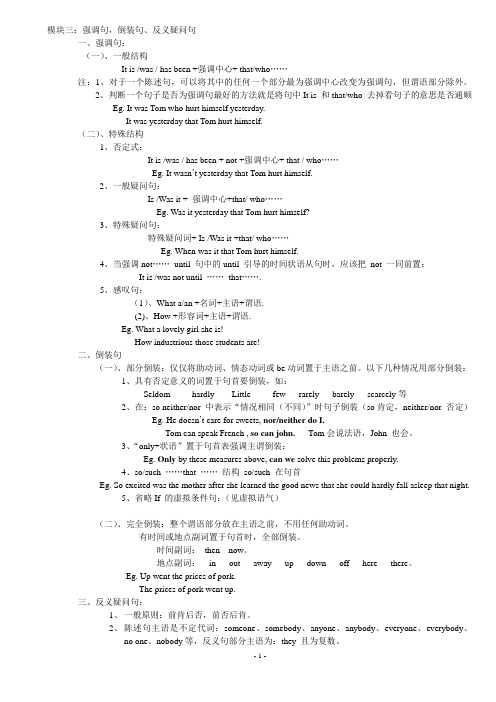
模块三:强调句,倒装句、反义疑问句一、强调句:(一)、一般结构It is /was / has been +强调中心+ that/who……注:1、对于一个陈述句,可以将其中的任何一个部分最为强调中心改变为强调句,但谓语部分除外。
2、判断一个句子是否为强调句最好的方法就是将句中It is 和that/who 去掉看句子的意思是否通顺Eg. It was Tom who hurt himself yesterday.It was yesterday that Tom hurt himself.(二)、特殊结构1、否定式:It is /was / has been + not +强调中心+ that / who……Eg. It wasn’t yesterday that Tom hurt himself.2、一般疑问句:Is /Was it + 强调中心+that/ who……Eg. Was it yesterday that Tom hurt himself?3、特殊疑问句:特殊疑问词+ Is /Was it +that/ who……Eg. When was it that Tom hurt himself.4、当强调not……until 句中的until 引导的时间状语从句时,应该把not 一同前置:It is /was not until ……that…….5、感叹句:(1)、What a/an +名词+主语+谓语.(2)、How +形容词+主语+谓语.Eg. What a lovely girl she is!How industrious those students are!二、倒装句(一)、部分倒装:仅仅将助动词、情态动词或be动词置于主语之前。
以下几种情况用部分倒装:1、具有否定意义的词置于句首要倒装,如:Seldom hardly Little few rarely barely scarcely等2、在:so neither/nor 中表示“情况相同(不同)”时句子倒装(so肯定,neither/nor 否定)Eg. He doesn’t care for sweets, nor/neither do I.Tom can speak French , so can john. Tom会说法语,John 也会。
高中英语语法:特殊句式
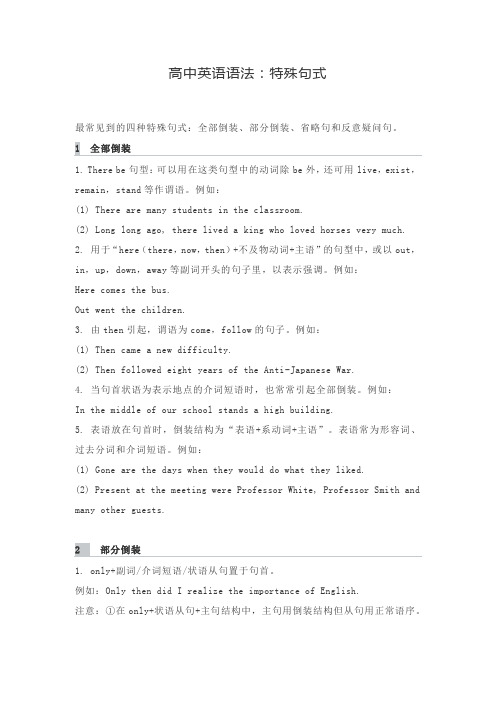
高中英语语法:特殊句式最常见到的四种特殊句式:全部倒装、部分倒装、省略句和反意疑问句。
1 全部倒装1. There be句型:可以用在这类句型中的动词除be外,还可用live,exist,remain,stand等作谓语。
例如:(1) There are many students in the classroom.(2) Long long ago, there lived a king who loved horses very much.2. 用于“here(there,now,then)+不及物动词+主语”的句型中,或以out,in,up,down,away等副词开头的句子里,以表示强调。
例如:Here comes the bus.Out went the children.3. 由then引起,谓语为come,follow的句子。
例如:(1) Then came a new difficulty.(2) Then followed eight years of the Anti-Japanese War.4. 当句首状语为表示地点的介词短语时,也常常引起全部倒装。
例如:In the middle of our school stands a high building.5. 表语放在句首时,倒装结构为“表语+系动词+主语”。
表语常为形容词、过去分词和介词短语。
例如:(1) Gone are the days when they would do what they liked.(2) Present at the meeting were Professor White, Professor Smith and many other guests.2 部分倒装1. only+副词/介词短语/状语从句置于句首。
例如:Only then did I realize the importance of English.注意:①在only+状语从句+主句结构中,主句用倒装结构但从句用正常语序。
特殊句式的类型
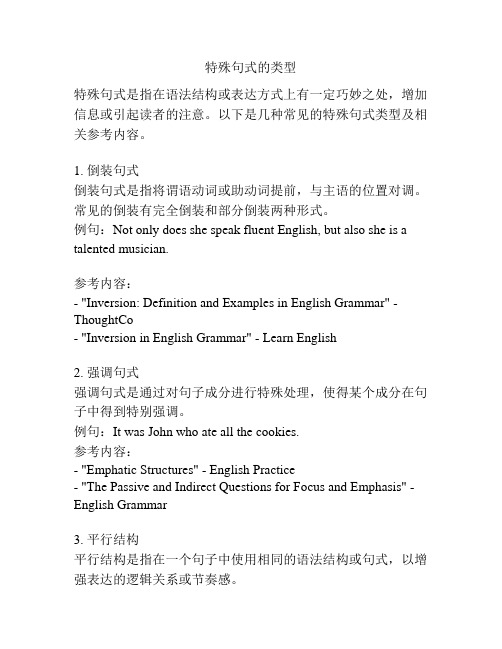
特殊句式的类型特殊句式是指在语法结构或表达方式上有一定巧妙之处,增加信息或引起读者的注意。
以下是几种常见的特殊句式类型及相关参考内容。
1. 倒装句式倒装句式是指将谓语动词或助动词提前,与主语的位置对调。
常见的倒装有完全倒装和部分倒装两种形式。
例句:Not only does she speak fluent English, but also she is a talented musician.参考内容:- "Inversion: Definition and Examples in English Grammar" - ThoughtCo- "Inversion in English Grammar" - Learn English2. 强调句式强调句式是通过对句子成分进行特殊处理,使得某个成分在句子中得到特别强调。
例句:It was John who ate all the cookies.参考内容:- "Emphatic Structures" - English Practice- "The Passive and Indirect Questions for Focus and Emphasis" - English Grammar3. 平行结构平行结构是指在一个句子中使用相同的语法结构或句式,以增强表达的逻辑关系或节奏感。
例句:She likes swimming, running, and cycling.参考内容:- "Parallel Structure" - Grammar Monster- "Parallelism: How to Write and Identify Parallel Sentences" - ThoughtCo4. 带有省略的句式带有省略的句式是指在句中可以省略某些成分或词语,但仍然能保持句子的完整性和可理解性。
高中英语特殊句式全面讲解及练习含答案
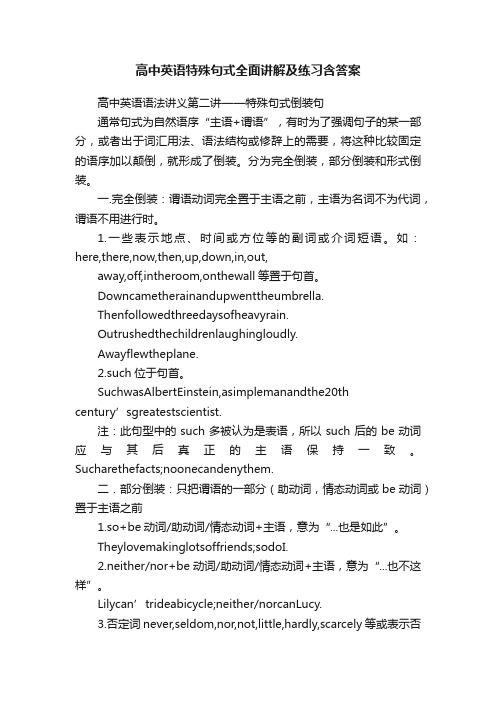
高中英语特殊句式全面讲解及练习含答案高中英语语法讲义第二讲——特殊句式倒装句通常句式为自然语序“主语+谓语”,有时为了强调句子的某一部分,或者出于词汇用法、语法结构或修辞上的需要,将这种比较固定的语序加以颠倒,就形成了倒装。
分为完全倒装,部分倒装和形式倒装。
一.完全倒装:谓语动词完全置于主语之前,主语为名词不为代词,谓语不用进行时。
1.一些表示地点、时间或方位等的副词或介词短语。
如:here,there,now,then,up,down,in,out,away,off,intheroom,onthewall等置于句首。
Downcametherainandupwenttheumbrella.Thenfollowedthreedaysofheavyrain.Outrushedthechildrenlaughingloudly.Awayflewtheplane.2.such位于句首。
SuchwasAlbertEinstein,asimplemanandthe20thcentury’sgreatestscientist.注:此句型中的such多被认为是表语,所以such后的be动词应与其后真正的主语保持一致。
Sucharethefacts;noonecandenythem.二.部分倒装:只把谓语的一部分(助动词,情态动词或be动词)置于主语之前1.so+be动词/助动词/情态动词+主语,意为“...也是如此”。
Theylovemakinglotsoffriends;sodoI.2.neither/nor+be动词/助动词/情态动词+主语,意为“...也不这样”。
Lilycan’trideabicycle;neither/norcanLucy.3.否定词never,seldom,nor,not,little,hardly,scarcely等或表示否定意义的介词短语atnotime,under/innocircumstances,innocase,bynomeans,onnoconditi on等置于句首时。
特殊句式讲解

特殊句式讲解特殊句型一、强调句1、强调句型强调句型由“It+Is/was+被强调部分+that/who…”构成,可以用来强调句子的主语、宾语、状语;被强调部分是指人的名词或代词时用who和that均可,其他情况一律用that,(1)强调句的一般疑问句式Is/Was it +被强调部分+that/who…?Was it yesterday that you met your old friend in the supermarket?(2)强调句的特殊疑问句式特殊疑问词(被强调部分)+Is/was+it+that/who…?①Why was it that you didn’t attend the meeting?②What was it that made her so upset?(3)not…until…句型的强调句It is /was+not u ntil…+that…It was not until I failed in the exams that I realized I had not studied hard.1、使用助动词do(does did)强调强调句子的谓语动词是时,将助动词do(does,did)置于动词原形之前,用来加强语气。
①Do be careful!②He does enjoy drawing.他确实喜欢画画。
二、倒装句1、部分倒转部分倒装指的是只将be动词、助动词或情态动词提到主语前面,谓语的其他部分仍保留在主语的后面。
(1)表示否定意义的词或短语置于句首时句子用部分倒装。
常见的这类词或短语有not,never,hardly,seldom,rarely,by no means,in no way,in no case,at no time等。
①Seldom in my life have I met so determined a person.②At no time should you touch it or get it hurt.(2) not only…but (also)…连接两个分句,not only…置于句首时,前一个分句用部分倒装。
祈使句,感叹句,反义疑问句,倒装句
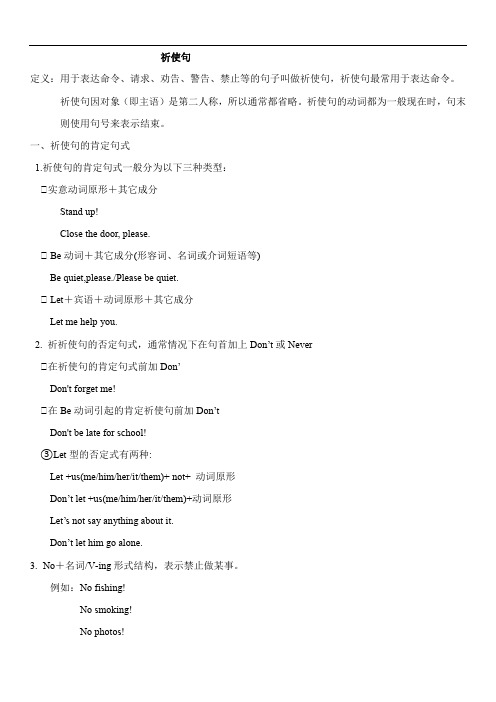
祈使句定义:用于表达命令、请求、劝告、警告、禁止等的句子叫做祈使句,祈使句最常用于表达命令。
祈使句因对象(即主语)是第二人称,所以通常都省略。
祈使句的动词都为一般现在时,句末则使用句号来表示结束。
一、祈使句的肯定句式1.祈使句的肯定句式一般分为以下三种类型:①实意动词原形+其它成分Stand up!Close the door, please.① Be动词+其它成分(形容词、名词或介词短语等)Be quiet,please./Please be quiet.① Let+宾语+动词原形+其它成分Let me help you.2. 祈祈使句的否定句式,通常情况下在句首加上Don’t或Never①在祈使句的肯定句式前加Don’Don't forget me!①在Be动词引起的肯定祈使句前加Don’tDon't be late for school!③Let型的否定式有两种:Let +us(me/him/her/it/them)+ not+ 动词原形Don’t let +us(me/him/her/it/them)+动词原形Let’s not say anything about it.Don’t let him go alone.3.No+名词/V-ing形式结构,表示禁止做某事。
例如:No fishing!No smoking!No photos!4.以may为句首的表示祝愿的祈使句.May you + 动词原形1) 祝你成功!May you succeed!2) 祝你一路平安!May you have a safe journey!5.don’t/doesn’t/didn’t后跟动词原形Please后跟动词原形练习:单项选择1. ________ stand too close to North Americans. Give them more personal space.A. Aren'tB. Didn'tC. Won'tD. Don't2. ---Is there a No. 2 bus stop near here?---Yes, there is. __________ at the second crossing, and you will find it.A. Turning leftB. Turn leftC. To turn leftD. Turns left3. —________. The baby is sleeping. I'm sorry.A. Not talkB. Not talkingC. Don't talkD. Can't talk4. — _______ late for school again, Tim! — Sorry, I promise that I _______.A. Don’t; won’tB. Don’t be; won’tC. Don’t be; don’tD. Don’t; will5. Don’t ___ shy. Everyone may make mistakes at the beginning.A. amB. isC. beD. are6. Please . The boy is studying.A. not noisyB. don’t noisyC. not to be noisyD. don’t be noisy7. —I’m leaving now. —________ you turn off the lights and the computer.A. To make sureB. Make sureC. Made sureD. Making sure8. Tony, ________, or you will get heavier.A. doesn't play sports any moreB. doesn't eat so much meatC. don't play sports any moreD. don't eat so much meat9. Don’t _______ too much TV. It’s bad for your eyes.A. watchingB. to watchC. watchD. watches10. —Would you please _______ near the river? Oh, sorry, I won’t.A. not playB.don’t playC. not to play11. — Please don’t make a noise. — ________ . I’ll be as quiet as a mouse.A. Yes, I doB. No, I don’tC. Yes, I willD. No, I won’t12. — ______, please.K-E-Y.A. What’s thisB. Spell itC. Can you spell itD. What is it13. _________ play in the street. It’s very dangerous.A. DoB. NotC. Don’tD. Doesn’t14. climb the tree! It’s too small. Come down quickly!A. Don’tB. Isn’tC. Aren’tD. Do15. —Don’t forget to close the door after school. — ________.A.OK, I won’tB.OK, I will.C.Yes, I do.D.No, I don’t.16. ---Sorry for being late again. ---__________here on time next time, or you’ll be punished.A. BeB. BeingC. To beD. Been17. _____ drive too fast .We have enough(足够的)time to get there.A. NotB. Don’tC. doesn’t18. Boys and girls, _____in bed. It’s bad for your eyesA. not readB. doesn’t readC. no readD. don’t read感叹句感叹句:表示赞美、惊叹、喜悦等感情;表达喜、怒、哀、乐、惊、恐等强烈情绪;感叹句分为两种:一种以what引导,一种以how引导。
特殊句式知识点总结

特殊句式知识点总结在英语写作中,句式的多样性是提高文章质量和表达效果的关键因素之一。
使用特殊句式可以丰富你的写作风格,增加语言的表现力。
本文将针对常见的特殊句式进行总结和讲解,帮助读者掌握不同的句式结构和用法,从而提高英语写作的水平。
一、倒装句1.完全倒装句主语和谓语动词的位置颠倒,常见于以下情况:- Here comes the bus.- Little did I know that she was watching.2. 部分倒装句只有助动词或情态动词与主语的位置颠倒,常见于以下情况:- Never have I seen such a beautiful sunset.- Not only does she play the piano well, but she also sings beautifully.3. 否定副词位于句首时的倒装在否定副词开头的句子中,主语和谓语动词颠倒,常见于以下情况:- Seldom have I seen him so angry.- Barely had I arrived when the phone started ringing.倒装句的使用可以增加句子的变化和灵活性,使句子更加生动、抓人,但需要注意的是,倒装句不能随意使用,要根据句子的语境和表达的意思来决定是否使用倒装句。
二、强调句强调句是通过强调句子的一部分来突出该部分的重要性,使信息更加突出。
英语中的强调句有两种形式:部分强调和完全强调。
1. 部分强调部分强调是通过在句中加入强调词来使该部分的信息得到突出:- It was John who broke the vase.- It's this book that I want to read.2. 完全强调完全强调是通过借助助动词do或情态动词will加上动词原形来实现强调:- It was he who broke the vase.- It is this book that I will read.强调句的使用可以使句子更加生动、突出重点,但使用时要注意强调的对象,避免造成句子表达的混淆或误解。
中考英语语法--祈使句感叹句反义疑问句it倒装句

中考英语语法--祈使句感叹句反义疑问句it倒装句没什么五种特殊句型祈使句感叹句反义疑问句It(形式主语、形式宾语、强调句)倒装句没什么没什么祈使句的肯定句式祈使句的肯定句式一般分为以下三种类型:1.行为动词原形+其它成分。
例如:Makeentenceafterthemodel.根据例句造句。
2.Be动词+其它成分(形容词、名词或介词短语等)。
例如:Becarefulwhencroingthetreet.过马路时要小心。
3.Let+宾语+动词原形+其它成分。
例如:Lethimgobacknow.让他现在回去吧。
没什么祈使句的否定句式,通常情况下在句首加上Dont或Never,一般分为以下三种类型:1.在祈使句的肯定句式前加Dont,构成Dont+行为动词原形+其它成分。
例如:Dontaythatagain!别再那样说了!2.在Be动词引起的肯定祈使句前加Dont,构成Dontbe+其它成分(形容词、名词或介词短语等)。
例如:Dontbecarele.不要粗心。
注意:在这种句型中be不能省略;否定副词not不可置于be之后。
3.在公共场合的提示语中,否定祈使句常用No+名词/Ving形式结构,表示禁止做某事。
例如:NOPHOTOS!禁止拍照!祈使句的否定句式没什么祈使句的回答祈使句的动作通常是表示将来发生的动作,所以回答祈使句时,一般用will或wont。
在回答具有否定意义的祈使句时,要注意两点:一是形式一致,即Ye与will保持一致;No与wont保持一致。
二是意思相反,即Ye是不的意思;No是“是”的意思。
在回答时,要注意分析上下文语境中所提供的条件。
没什么---Dontgoout,pleae.Itrainingheavilyoutide.请不要出去。
外面雨下得很大。
----Ye,Iwill.Ihavetomeetmybrotherattheairport.不行,我得去机场接我弟弟。
没什么没什么表示喜、怒、乐等强烈感情时用感叹句。
- 1、下载文档前请自行甄别文档内容的完整性,平台不提供额外的编辑、内容补充、找答案等附加服务。
- 2、"仅部分预览"的文档,不可在线预览部分如存在完整性等问题,可反馈申请退款(可完整预览的文档不适用该条件!)。
- 3、如文档侵犯您的权益,请联系客服反馈,我们会尽快为您处理(人工客服工作时间:9:00-18:30)。
几种特殊句式讲解及练习倒装句、强调句、反意疑问句、祈使句倒装Inversions1 倒装句之全部倒装全部倒装是只将句子中的谓语动词全部置于主语之前。
此结构通常只用与一般现在时和一般过去时。
常见的结构有:1) here, there, now, then, thus等副词置于句首, 谓语动词常用be, come, go, lie, run。
There goes the bell.Then came the chairman.Here is your letter.2) out, in, up,down,away表示运动方向的副词或地点状语置于句首,谓语表示运动的动词。
Out rushed a missile from under the bomber.Ahead sat an old woman.注意:上述全部倒装的句型结构的主语必须是名词,如果主语是人称代词则不能完全倒装。
Here he comes.Away they went.2 倒装句之部分倒装部分倒装是指将谓语的一部分如助动词或情态倒装至主语之前。
如果句中的谓语没有助动词或情态动词,则需添加助动词do, does或did,并将其置于主语之前。
○1句首为否定或半否定的词语,如no, not, never, seldom, little, hardly, at notime, in no way, not until…等。
Never have I seen such a performance.Nowhere will you find the answer to this question.Not until the child fell asleep did the mother leave the room.当Not until引出主从复合句,主句倒装,从句不倒装。
注意:如否定词不在句首不倒装。
I have never seen such a performance.The mother didn't leave the room until the child fell asleep.典型例题1)Why can't I smoke here?At no time___ in the meeting-roomA. is smoking permittedB.smoking is permittedC. smoking is it permittedD.does smoking permit这是一个倒装问题。
当否定词语置于句首以表示强调时,其句中的主谓须用倒装结构。
这些否定词包括no, little, hardly, seldom, never, not only, not until等。
本题的正常语序是Smoking is permitted in the meeting-room at no time.2)Not until the early years of the 19th century ___ what heat is.A. man did knowB. man knowC. didn't man knowD. did man know看到Not until…的句型,我们知道为一倒装句,答案在C,D 中选一个。
改写为正常语序为,Man did not know what heat is until the early years of the 19th. 现在将not提前,后面就不能再用否定了,否则意思就变了。
○2以否定词开头作部分倒装如Not only…but also, Hardly/Scarcely…when, No sooner…thanNot only did he refuse the gift, he also severely criticized the sender.Hardly had she gone out when a student came to visit her.No sooner had she gone out than a student came to visit her.典型例题No sooner___ than it began to rain heavily.A. the game beganB.has the game begunC. did the game beginD.had the game begun答案以具有否定意义的副词放在句首时,一般采用倒装句(谓语前置)。
这类表示否定意义的词有never, seldom, scarcely, little, few, not, hardly, 以及not only…but (also), no sooner…than, hardly…when scarcely…when等等。
注意:只有当Not only…but also连接两个分句时,才在第一个分句用倒装结构。
如果置于句首的Not only…but also仅连接两个并列词语,不可用倒装结构。
Not only you but also I am fond of music.○3so, neither, nor作部分倒装以so/neither起首的倒装句,结构为so/neither+谓语(助动词/be动词/情态动词)+主语,用于说明上文所描述的情况也同样适用于下文的人或物。
该结构中谓语动词的选择在形式上要和上文的谓语保持一致,数要由下文的主语来决定。
注意,在“so+谓语+主语”的结构中,主语是另外的人或物,而在“so+主语+谓语”的结构中,主语仍是上文的人或物,表示对上文所讲事实的肯定或强调,如,She can play the piano, so she can.(她会弹钢琴,她的确会。
)(1)He can sing a lot of English songs, so can she.他会唱很多英语歌曲,她也是。
(2)She speaks English very well, so do I.她英语说得好,我也是。
(3)Li Lei hasn’t read this book, neither has Lin Feng.李蕾没看过这本书,林风也没看过。
She went to school just now. So did I . 她刚才去学校了,我也是She has finished the work. So have I . 她已经完成了工作,我也完成了。
She will go to school. So will he.她将去学校,他也是。
典型例题---Do you know Jim quarreled with his brother?---I don't know, _____.A. nor don't I careB. nor do I careC. I don't care neitherD. I don't care also答案:B. nor为增补意思"也不关心",因此句子应倒装。
A错在用don't 再次否定,C neither 用法不对且缺乏连词。
D缺乏连词。
注意:当so引出的句子用以对上文内容加以证实或肯定时,不可用倒装结构。
意为"的确如此"。
Tom asked me to go to play football and so I did.---It's raining hard.---So it is.○4 only在句首要倒装的情况Only in this way, can you learn English well.Only after being asked three times did he come to the meeting.如果句子为主从复合句,则主句倒装,从句不倒装Only when he is seriously ill, does he ever stay in bed.其他部分倒装1)so…that 句型中的so 位于句首时,需倒装。
So frightened was he that he did not dare to move an inch.2)在某些表示祝愿的句型中:May you all be happy.3)在虚拟语气条件句中从句谓语动词有were, had, should等词,可将if 省略,把were, had, should 移到主语之前,采取部分倒装。
Were I you, I would try it again.There be句型是一种特殊的句子,真正的主语在后面,含义为“有……”①谓语动词和主语保持一致:There is a television in the sitting room.②有两个或更多的主语时,动词一般和最近的一个保持一致:There are two girls and a boy dancing in the hall.③主语的后面有时有修饰语:There are a lot of difficulties facing us. There were many things to be done. (此处也可以使用to do).④谓语动词be可以有时态的变化:There will be a concert in the park tonight. There was little change in him.⑤谓语也可以有不定式构成的复合谓语。
There used to be a cinema here.There seems to be something the matter with her.Is there going to be any activity tonight?⑥ there be句式变疑问句,把be提前;变反意疑问句也要借助there。
Is there any hope of getting the job?There is nothing wrong with your watch,is there?⑦there be句型中也可以使用诸如:live,follow,come,stand,sit,exist等不及物动词:Once upon a time, there lived a fisherman on the island.There came a knock at the door.At the top of the hill there stands an old temple.⑧用于非谓语的情况下,有时用不定式的复合结构there to be或动名词的复合结构和独立主格结构there being:You wouldn't want there to be another war. (不定式的复合结构)The teacher was satisfied with there being no mistakes in his homework. (动名词的复合结构)There being nothing else to do,we went home. (独立主格结构)强调句强调句型是英语中常用句子结构,又是高考中的常见考点,其基本结构为:It + be+ 被强调部分+that+句子其余部分。
